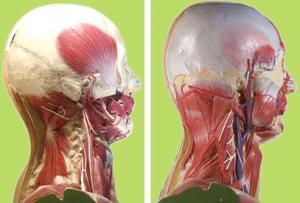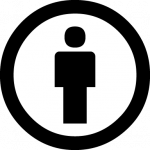
Image adapted from EUSKALANATO under a Creative Commons license: BY-NC-SA.
The neuroscience sequence is foundational in nature and stresses the organizational principles and structure/function relationships in the central nervous system. The course emphasizes the relationship between the gross organization of the Central Nervous System (CNS), its subdivision into specialized regions and the corresponding perceptions of sensory information and the nervous system control of behavior. The cell biology of the neuron, neurotransmitter systems and neuronal injury and repair are also emphasized.
Sequence Director:
Peter Hitchcock, Ph.D.
dScribe: Erqi Liu
Syllabus
Learning Outcomes
The Neuroscience Sequence is foundational in nature and stresses the organizational principles and structure/function relationships in the central nervous system. The course emphasizes the relationship between the gross organization of the CNS, its subdivision into specialized regions and the corresponding perceptions of sensory information and the nervous system control of behavior. The cell biology of the neuron, neurotransmitter systems and neuronal injury and repair are also emphasized.
It is intended that upon completion of this sequence students know and understand both the external and internal anatomy of the central nervous system, including the clinically relevant sensory and motor pathways. In addition, students will know the histology and cell biology of neurons and some molecular details of neurotransmitters and synaptic communication. Students will know the anatomy of the cranium and vascular supply to the brain as well as the histology of neurons and the special sensory organs, eye and ear.
Sequence Examination and Grading
Performance will be assessed by two Friday quizzes and a comprehensive final examination. The quizzes on Friday, March 13 and 20, will be all done online and will be multiple choice questions. Each quiz will cover material up to and including Friday’s lectures. The final exam will include both written and practical portions. The written portion will be available on Friday, March 27 @ 5:00 PM. The examinations for gross anatomy and neuroanatomy will include practicals and will be conducted on Friday afternoon, March 27. The number of exam questions will be approximately proportional to the time allocated for lectures and laboratory hours. All exam questions weigh equally and are worth 1 point. To pass the sequence, students must achieve a minimum score of 75% on the quizzes and final exam as usual, and fulfill the requirements of the longitudinal case small groups.
Textbook
In addition to the texts that you have used throughout the year in previous sequences, there is an additional, recommended text: Martin, John H. Neuroanatomy: Text & Atlas, Appleton & Lange, 3rd edition, 2003, ISBN: 007138183X
Learning Outcomes
The Neuroscience Sequence is foundational in nature and stresses the organizational principles and structure/function relationships in the central nervous system. The course emphasizes the relationship between the gross organization of the CNS, its subdivision into specialized regions and the corresponding perceptions of sensory information and the nervous system control of behavior. The cell biology of the neuron, neurotransmitter systems and neuronal injury and repair are also emphasized.
It is intended that upon completion of this sequence students know and understand both the external and internal anatomy of the central nervous system, including the clinically relevant sensory and motor pathways. In addition, students will know the histology and cell biology of neurons and some molecular details of neurotransmitters and synaptic communication. Students will know the anatomy of the cranium and vascular supply to the brain as well as the histology of neurons and the special sensory organs, eye and ear.
Reading List
The recommended text for this sequence is : Martin, John H. Neuroanatomy: Text & Atlas, Appleton & Lange, 3rd edition, 2003, ISBN: 007138183X

Image adapted from EUSKALANATO under a Creative Commons license: BY-NC-SA.
| Document Title | Creator | Downloads | License |
|---|---|---|---|
|
Syllabus |
Peter Hitchcock
|
| Document Title | Creator | Downloads | License |
|---|---|---|---|
|
03.09.09(a) Lecture Handout: Introduction |
Peter Hitchcock
|
||
|
03.09.09(b) Lecture Handout: Spinal Cord & Spinal Nerves part I |
Dept. Staff
|
||
|
03.16.09(a) Lecture Handout: Diencephalon |
Peter Hitchcock
|
||
|
03.16.09(b) Lecture Handout: Cerebral Hemispheres |
Peter Hitchcock
|
||
|
03.17.09(a) Lecture Handout: Cerebellum |
Peter Hitchcock
|
||
|
03.17.09(a) Lecture Handout: Cerebellum Diagrams |
Peter Hitchcock
|
||
|
03.17.09(b) Lecture Handout: Basal Ganglia |
Peter Hitchcock
|
||
|
03.17.09(b) Lecture Handout: Basal Ganglia Diagram |
Peter Hitchcock
|
||
|
03.18.09(b) Lecture Handout: Hypothalmus |
Dept. Staff
|
||
|
03.18.09(b) Lecture Handout: Hypothalmus and Limbic System Table |
Dept. Staff
|
||
|
03.19.09 Lecture Handout: Limbic System |
Dept. Staff
|
||
|
03.20.09 Lecture Handout: Retina and Central Visual Pathways |
Peter Hitchcock
|
| Document Title | Creator | Downloads | License |
|---|---|---|---|
|
03.09.09(a): Introduction |
Peter Hitchcock
|
||
|
03.09.09(b): Spinal Cord & Spinal Nerves, part I |
Dept. Staff
|
||
|
03.09.09(c): Histology of the Central Nervous System |
Michael Hortsch
|
||
|
03.16.09(a): Diencephalon |
Peter Hitchcock
|
||
|
03.16.09(b): Cerebral Cortex |
Peter Hitchcock
|
||
|
03.17.09(a): Cerebellum |
Peter Hitchcock
|
||
|
03.17.09(b): Basal Ganglia |
Peter Hitchcock
|
||
|
03.18.09(a): Hypothalamus Pituitary Development |
Dept. Staff
|
||
|
03.18.09(b): Hypothalmus |
Dept. Staff
|
||
|
03.18.09(c): Eye Histology |
Michael Hortsch
|
||
|
03.18.09(d): Ear Histology |
Matthew Velkey
|
||
|
03.19.09: Limbic System |
Dept. Staff
|
||
|
03.20.09: Retina and Visual System |
Peter Hitchcock
|
| Document Title | Creator | Downloads | License |
|---|---|---|---|
|
2007 Daily Schedule: M1 CNS / Head & Neck |
Dept. Staff
|
||
|
2008 Daily Schedule: M1 CNS / Head & Neck |
Dept. Staff
|
||
|
2009 Daily Schedule: M1 CNS / Head & Neck |
Dept. Staff
|
||
|
2010 Daily Schedule: M1 CNS / Head & Neck |
Dept. Staff
|



